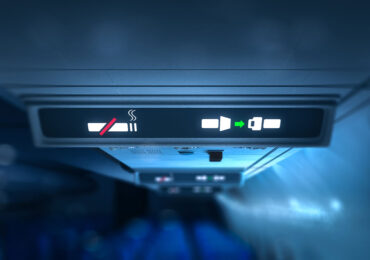Almost every plane traveler has experienced turbulence when flying. Especially when it’s severe, turbulence can feel quite scary. However, the truth is more reassuring. What is turbulence on a plane? Keep reading to find the answer to this question and learn more about what causes turbulence and how it works. Let’s see what turbulence is when flying, and why it happens.
What Is Turbulence?
Turbulence is the irregular movement of air that can cause the airplane to shake or bump during a flight. It occurs when different air currents intersect or when the plane passes through clouds, storms, or wind patterns. While it may feel dramatic, turbulence is a normal part of flying and pilots are trained to handle it safely.
There are different levels of turbulence: light, moderate, and severe. Most of the time, the turbulence you feel is light or moderate, which only causes small bumps. Severe turbulence is less common, and although it might feel scary, planes are built to withstand it. It’s like hitting a pothole while driving. (Uncomfortable, but usually not dangerous.) So next time you feel turbulence when flying, try not to worry. Fasten your seatbelt, stay calm, and trust the crew. Pilots usually know when turbulence is coming and try to avoid it when possible. And remember that turbulence is mostly a normal part of air travel, not a sign that something is wrong.
3 Types of Turbulence
When you experience turbulence on a plane, it feels random. There are several types of turbulence, each with its own unique characteristics and reasons. Knowing the difference between them can help passengers feel more at ease during bumpy flights. Let’s take a closer look at the 3 types of turbulence
- Clear Air Turbulence (CAT): This type of turbulence happens at high altitudes, usually above 20,000 feet, and it’s not connected to any visible weather conditions like clouds or storms. That’s why it often surprises both pilots and passengers. It usually occurs when a plane flies near or through fast-moving air currents, such as jet streams. Although it can feel sudden and shaky, clear air turbulence is not inherently dangerous, and planes are designed to handle it effectively.
- Thermal Turbulence: As the name implies, thermal turbulence is caused by warm air rising from the ground. It’s more common during daytime flights, especially over land and in hot climates. As the sun heats the Earth, warm air rises and mixes with cooler air. This can cause the plane to bounce slightly as it passes through these areas. It’s most often felt during takeoff or landing, or when flying over mountains or deserts.
- Mechanical Turbulence: Mechanical turbulence occurs when air flows over obstacles such as buildings, mountains, or rough terrain. These obstacles disturb the airflow and create small currents. If your flight path includes mountainous areas, this type of turbulence might be more likely. Again, while it may feel a bit uncomfortable, it’s a normal part of flying conditions and nothing to be afraid of.


What Causes Turbulence when Flying?
The answer to the question “What causes turbulence when flying?” is mostly related to the unstable air conditions. There are many reasons why the air can become bumpy. One of the primary causes is wind, particularly strong winds at high altitudes, such as jet streams. Another cause is the weather, such as storms or clouds. Hot air rising from the ground can also make the plane shake. And when a plane flies near mountains or buildings, the air can become disrupted, creating turbulence. All of these things push and pull on the airplane as it moves through the sky. While it may feel uncomfortable, it’s usually not dangerous, and pilots are trained to handle it.
Is Turbulence Normal when Flying?
This is one of the most commonly asked questions, and yes, turbulence is very normal when flying. It happens on most flights, even if it’s not always strong. Air in the sky is constantly moving, and planes pass through these moving air pockets. This is similar to a boat navigating small waves in the sea. Pilots expect turbulence and know how to deal with it. Modern planes are built to handle it safely. So, even if it feels uncomfortable for a few moments, there’s usually no reason to worry. Just fasten your seatbelt and relax until it passes.
For details about the safest ways to travel, don’t forget to read our blog post “Safest Means of Transportation“.















